Initial assessment of nasopharyngeal carcinoma: Added value of PET/MRI
This case involves a 60-year-old female smoker who presented with ear discomfort.
Subsequent clinical examination and work-up showed a large nasopharyngeal mass. Biopsy revealed invasive squamous cell carcinoma, which was p16 positive but Epstein-Barr virus negative.
Imaging findings
The patient underwent an initial staging 18F-fluorodeoxyglucose (FDG) PET/MRI examination, which showed a large, necrotic mass with enhancing components at the central skull base completely replacing the clivus and sphenoid body.

The majority of the mass was behind the nasopharyngeal mucosal surface; however, the nasopharynx itself was pushed anteriorly and deformed by mass effect.
The tumor measured 3.5 cm by 3.6 cm by 4.1 cm, with the hypermetabolic solid enhancing component demonstrating maximum standard uptake value (SUVmax) of 16.6.
The mass extended into the left pterygoid plate, causing remodeling and infiltration of the lesser wing of the sphenoid bone. The sellar floor was abutted by the mass but remained intact.
Inferiorly, the mass extended to the level of the C1 anterior arch without destruction. Bilateral occipital condyle anterior cortices also were eroded by the mass.
In addition, the mass extended intracranially along the prepontine cistern, although the pontine parenchyma was free of mass effect. The basilar artery was abutted and dorsally displaced by the mass without encasement.
The most lateral and posterior extension of the mass was noted along the petrous apices, with associated osseous dehiscence along the neighboring medial carotid canals. Bilateral distal petrous segments of the internal carotid arteries also were abutted by the mass but remained patent.
There were bilateral retropharyngeal necrotic lymph nodes, larger on the left side, and measuring 2 cm by 1.5 cm (transverse by anteroposterior), with the solid enhancing component of the left retropharyngeal lymph node demonstrating increased FDG uptake with SUVmax 6.2.
Bilateral cervical level II-IV partially necrotic lymph nodes demonstrated a maximum transaxial diameter of 1.2 cm at right level IIb, 1.1 cm at left level IIb, 0.6 cm at right level III, 1 cm at left level IV and 0.9 cm left level III. There also was a necrotic left level III/Vb lymph node that measured 1 cm. These lymph nodes were associated with hypermetabolism and SUVmax values of 3 to 8.
There was no evidence of distant metastases.
Discussion
Our patient was referred for staging 18F-FDG PET/MRI of her known locally advanced nasopharyngeal squamous cell carcinoma. Overall, her imaging findings were in keeping with the patient’s clinical history of an endophytic nasopharyngeal malignancy that has eroded through the clivus and sphenoid bone, stage T4N2M0.
18F-FDG PET/CT is the standard of care in the evaluation of patients with nasopharyngeal cancer. However, multiple studies have showed that — although PET/CT certainly provides high sensitivity — there is significant heterogeneity, particularly in the diagnosis of residual or recurrent nasopharyngeal carcinoma.
Not only is it at times difficult to differentiate posttreatment changes from recurrent and residual neoplasm, but oftentimes normal structures in the head and neck region — including the nasal turbinates, major and minor salivary glands, oropharyngeal musculature, and lymphatic tissue in Waldeyer’s ring — demonstrate variable and asymmetric FDG uptake, therefore leading to false-positive results.
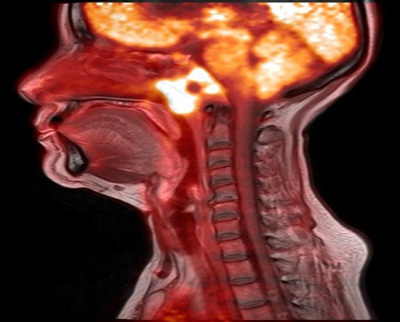
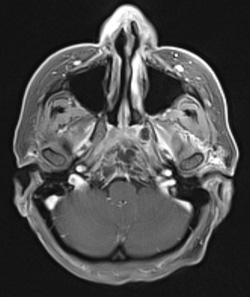
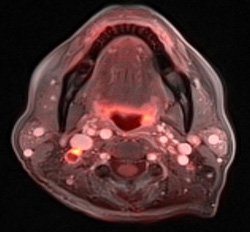
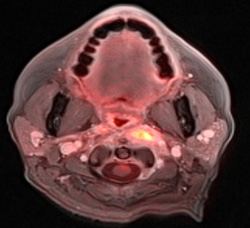
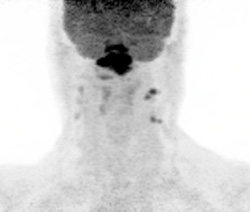
Source: Munir Ghesani, MD, FACNM.
In addition, variations in normal mucosal uptake and various inflammatory lesions can lead to focal FDG uptake in the head and neck.
Early detection and accurate staging of nasopharyngeal malignancy is necessary to ensure optimal clinical treatment and, therefore, improve individual patient outcomes and extend OS.
More recently, routine initial MRI examination has been added to 18F-FDG PET/CT assessment of these patients, used as complementary methods in the initial diagnosis, staging and posttreatment evaluation of head and neck squamous cell carcinoma.
The added value of MRI specifically lies in its vastly superior soft-tissue contrast resolution, which is imperative for the appropriate assessment of mucosal and soft tissue surfaces to determine local disease extent.
Meanwhile, the functional FDG component of PET/CT allows for accurate delineation of both cervical nodal stations, as well as distant metastatic disease. Additionally, 18F-FDG PET/CT also has been established during treatment, as well as in the early postradiation therapy time window for patients with head and neck cancer for the implementation of “adaptive” radiation therapy — during ongoing treatment — so as to minimize complications.
Further, several studies have shown nasopharyngeal cancer to be typically associated with decreased apparent diffusion coefficients (ADC) on diffusion-weighted MRI, in addition to the already validated increase in SUVs on 18F-FDG PET/CT. This association between diffusion restriction, glucose metabolism and histopathological parameters among patients with head and neck squamous cell carcinoma is becoming increasingly more utilized with the addition of simultaneous 18F-FDG PET/MRI imaging in the clinical setting.
For these patients, ADC and SUV values show significant correlation with various histopathological parameters and have been postulated as reproducible and independent biomarkers in the initial assessment and follow-up evaluation of patients with nasopharyngeal malignancy.
After her initial staging 18F-FDG PET/MRI showed locally advanced stage T4N2M0 disease, our patient started concomitant radiation and chemotherapy with cisplatin, followed by adjuvant treatment with cisplatin and 5-FU.
References:
Blodgett TM, et al. Radiographics. 2005;25:897-912.
Fukui M, et al. Radiology. 2001;221(P):678.
Hanasono MM, et al. Laryngoscope. 1999;109:880-885.
Lai V and Khong PL. Oral Oncol. 2014;doi:10.1016/j.oraloncology.2013.05.005.
Meltzer C, et al. Radiology. 2001;221(P):678.
Surov A, et al. Oral Oncol. 2016;doi:10.1016/j.oraloncology.2016.04.009.
Varoquaux A, et al. Eur J Nucl Med Mol Imaging. 2013;doi:10.1007/s00259-013-2351-9.
Zhou H, et al. J Nucl Med. 2016;doi:10.2967/jnumed.115.165407.
For more information:
Ana M. Franceschi, MD, is a neuroradiology fellow at NYU Langone Medical Center.
Elcin Zan, MD, is assistant professor of radiology in the section of neuroradiology at NYU Langone Medical Center.
Munir Ghesani, MD, FACNM, is assistant professor of radiology and director of PET/CT fellowship at NYU Langone Medical Center in New York. He also is a HemOnc Today Editorial Board Member. He can be reached at munir.ghesani@nyumc.org.
Disclosures: Franceschi, Zan and Ghesani report no relevant financial disclosures.
